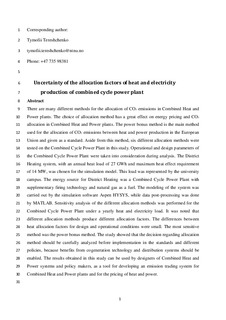| dc.contributor.author | Tereshchenko, Tymofii | |
| dc.contributor.author | Nord, Natasa | |
| dc.date.accessioned | 2019-01-21T12:28:10Z | |
| dc.date.available | 2019-01-21T12:28:10Z | |
| dc.date.created | 2014-12-05T13:54:05Z | |
| dc.date.issued | 2015 | |
| dc.identifier.citation | Applied Thermal Engineering. 2015, 76 410-422. | nb_NO |
| dc.identifier.issn | 1359-4311 | |
| dc.identifier.uri | http://hdl.handle.net/11250/2581526 | |
| dc.description.abstract | There are many different methods for the allocation of CO2 emissions in Combined Heat and Power plants. The choice of allocation method has a great effect on energy pricing and CO2 allocation in Combined Heat and Power plants. The power bonus method is the main method used for the allocation of CO2 emissions between heat and power production in the European Union and given as a standard. Aside from this method, six different allocation methods were tested on the Combined Cycle Power Plant in this study. Operational and design parameters of the Combined Cycle Power Plant were taken into consideration during analysis. The District Heating system, with an annual heat load of 27 GWh and maximum heat effect requirement of 14 MW, was chosen for the simulation model. This load was represented by the university campus. The energy source for District Heating was a Combined Cycle Power Plant with supplementary firing technology and natural gas as a fuel. The modeling of the system was carried out by the simulation software Aspen HYSYS, while data post-processing was done by MATLAB. Sensitivity analysis of the different allocation methods was performed for the Combined Cycle Power Plant under a yearly heat and electricity load. It was noted that different allocation methods produce different allocation factors. The differences between heat allocation factors for design and operational conditions were small. The most sensitive method was the power bonus method. The study showed that the decision regarding allocation method should be carefully analyzed before implementation in the standards and different policies, because benefits from cogeneration technology and distribution systems should be enabled. The results obtained in this study can be used by designers of Combined Heat and Power systems and policy makers, as a tool for developing an emission trading system for Combined Heat and Power plants and for the pricing of heat and power. | nb_NO |
| dc.language.iso | eng | nb_NO |
| dc.publisher | Elsevier | nb_NO |
| dc.rights | Attribution-NonCommercial-NoDerivatives 4.0 Internasjonal | * |
| dc.rights.uri | http://creativecommons.org/licenses/by-nc-nd/4.0/deed.no | * |
| dc.title | Uncertainty of the allocation factors of heat and electricity production of combined cycle power plant | nb_NO |
| dc.type | Journal article | nb_NO |
| dc.type | Peer reviewed | nb_NO |
| dc.description.version | acceptedVersion | nb_NO |
| dc.source.pagenumber | 410-422 | nb_NO |
| dc.source.volume | 76 | nb_NO |
| dc.source.journal | Applied Thermal Engineering | nb_NO |
| dc.identifier.doi | 10.1016/j.applthermaleng.2014.11.019 | |
| dc.identifier.cristin | 1181423 | |
| dc.description.localcode | © 2015. This is the authors’ accepted and refereed manuscript to the article. This manuscript version is made available under the CC-BY-NC-ND 4.0 license http://creativecommons.org/licenses/by-nc-nd/4.0/ | nb_NO |
| cristin.unitcode | 194,64,25,0 | |
| cristin.unitname | Institutt for energi- og prosessteknikk | |
| cristin.ispublished | true | |
| cristin.fulltext | postprint | |
| cristin.qualitycode | 1 | |

